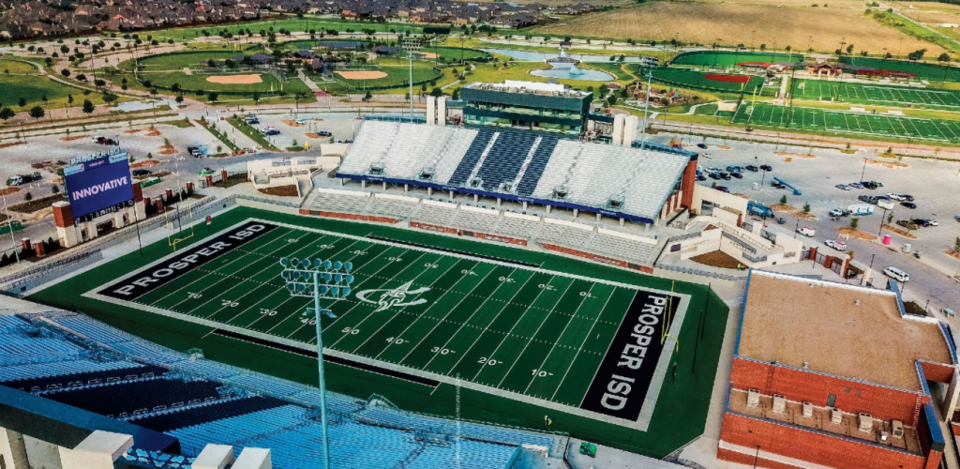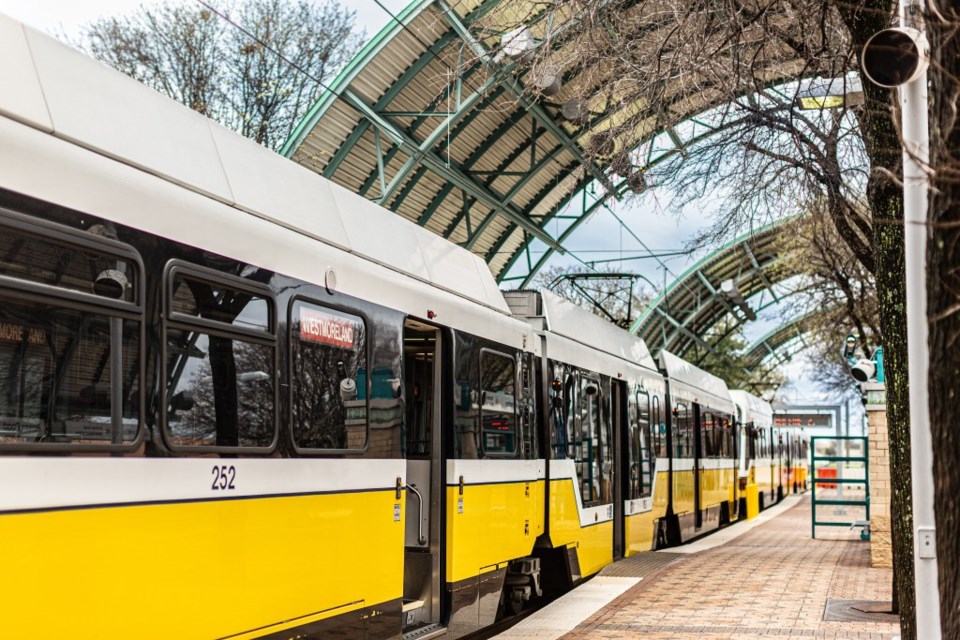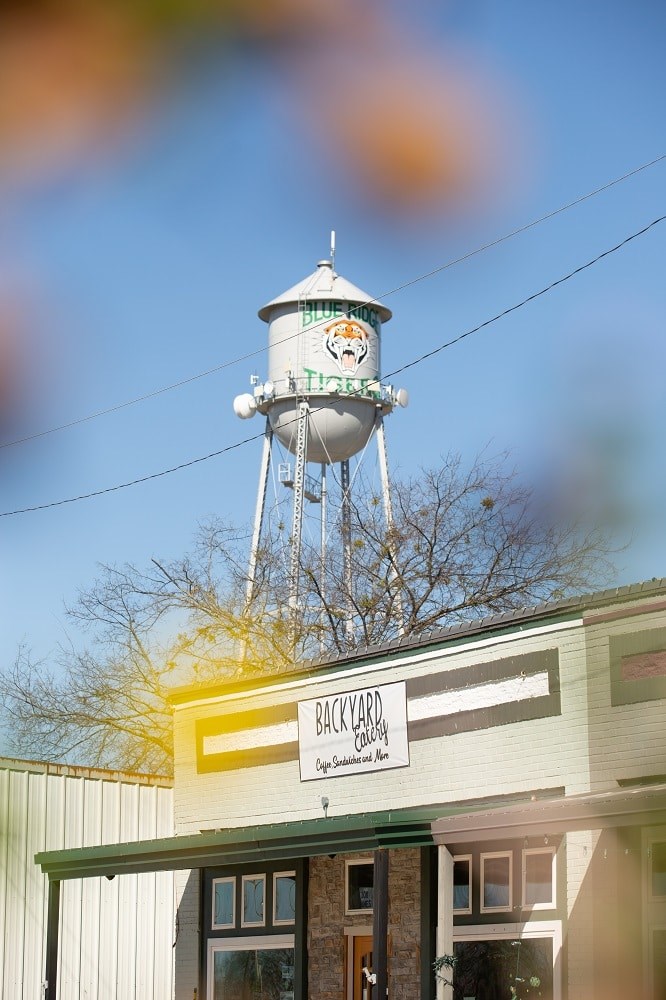When Shannon Fought moved several years ago to Texas, she was looking for wide open spaces, a break from the congested highways she had grown up with in Southern California. Fought, 35, thought she found the perfect fit in the acre lots of McKinney, not too far from the shopping comforts of home. Collin County's population growth was not in her plans.
But more traffic soon followed, pushing her, her husband, and two children out farther to the open fields of Celina.
“Two years later, I could see from my front yard the concrete beams of the Dallas North Tollway going up,” she says. “We couldn’t believe it.”
She wanted to open a small restaurant, but affordable storefront space in Celina was becoming more difficult to find amidst the franchises that started populating town square. So she packed up and moved to Blue Ridge, a community of almost 1,000 residents that dubs itself “home of the last Texas prairie,” tucked away in the northeastern edge of Collin County.
In August 2019, Fought opened Backyard Eatery, a sandwich shop in the Blue Ridge square occupying a refurbished storefront that once was an old car garage.
Blue Ridge, a town with one grocery store and no stoplights, is uniquely situated at State Highway 78, FM 545, and FM 981 in the flood plains of the branches of Lake Lavon. Not a lot of growth has come to the area since it weathered a 1919 tornado and the 1930s Depression. In a town where the population swells for high school football games and rodeos, most residents drive 30 minutes away mostly to McKinney to work.
Most folks like it that way, holding on tight to their acreage as development of the Collin County Outer Loop and the 16,641-acre Bois d’Arc reservoir looms in the near future.

Collin County's Population Growth
Despite the COVID-19 pandemic, growth is knocking on Blue Ridge’s door. Driving east on FM545 toward Melissa, one can’t miss the freshly framed houses and “now open” signs popping up along new roads under construction. A new stoplight blinks as cars back up near the town’s border. As you enter Blue Ridge, the landscape quickly turns to rolling expanses of land, rolled hay and grazing horses.
If growth does come to Blue Ridge, it’s 10 to 20 years away, says Edie Simms, Blue Ridge city secretary. But that’s a big “if,” she adds.
“Do we need to prepare now? Development is about sewers: do we have the availability for if development does come our way?” she asks rhetorically. “We’re always looking for ways to prepare, just in case.”
Discussions quickly turn to how cities are going to support new roads, schools, and police and fire protection.
Signs of progress are all around Collin County. Dale Webb, 64, of Blue Ridge, worked county road construction for two decades. He points out that many of the asphalt roads and old bridges are not designed to handle increased traffic that comes with growing populations. “I saw 700 miles of old county roads lost to new development,” he says.
Old-timers can’t deny what they see happening around them. Abandoned barns are being torn down and fences are being moved back for the widening of Texas State Highway 121 heading north from Frisco past McKinney, connecting two of the nation’s 15 fastest-growing cities.
Along 121, the Collin County population has grown over the past five years. From 2015 to 2019, Melissa grew 37.8 percent, according to data by the North Central Texas Council of Governments and the US Census. Princeton—east of McKinney on Highway 380—saw a 35.4 percent increase from 2015 to 2019. Celina to the west grew by a whopping 50.8 percent, data shows.
Collin County population growth means more than 1 million residents have moved here, with a 30,000 increase from the previous year, the U.S. Census Bureau reports. That comes to almost 100 new folks moving here every day, including some 4,000 employees who came from the West Coast when Toyota moved its national headquarters to Plano. According to Bisnow, since 2000, Collin County has experienced the highest sustained growth rate of any U.S. county with more than a half-million people. The Texas Demographic Center projects that Collin County will have over 2.4 million residents by 2050. Other estimates predict a population as high as 3.5 million.
In 2020, amid the COVID-19 pandemic, Anna had an unprecedented 64 percent surge in single-family home permits, the largest jump in recent history with nearly 1,000 permits issued.
“I was in my dad’s garage when a van of Toyota employees drove up to ask if the house was for sale,” says Ricky Simms, 61, Edie’s husband. “We sold it for a lot more than we paid for it.”
The Simms couple, who raised their six daughters in Blue Ridge, admit they wouldn’t mind having a few amenities closer by. A farm equipment store would be nice, they said. As more children and grandchildren who grew up in Blue Ridge ponder moving closer to their parents who stayed, the Trails of Blue Ridge is in its second phase of construction with acre lots south of town. “Development helps with taxes and brings in revenue,” Ricky Simms says.
As Fought has found, you can’t run from growth.
“It will find you,” she says. “You can’t escape it.”

One Stoplight Town
Ray Smith can remember when Prosper had one stoplight and one grocery store, not that much different than today’s Blue Ridge.
Fifteen years later, he embraces population growth as mayor of Prosper, one of the fastest growing cities in Collin County at State Highway 380 and Dallas North Tollway.
Dump trucks and concrete mixers compete for road space in this city of about 27,000 residents and more than a half dozen grocery stores. A new movie theater anchors the southwest corner of the Dallas North Tollway and Highway 380 where additional lanes for northbound and southbound traffic are being added.
Coit Road is being widened to carry additional traffic into Prosper. Construction of a bridge at the tollway over Highway 380 is expected to begin this summer.
The 27-square-mile town that was established as a rail stop in 1902 today brings in 30 families per week—each with 2.5 kids.
“We’re building roads and schools as fast as we can to keep up,” Smith says.
In addition to roads, the biggest challenge, he says, is building infrastructure to support the growth that includes two new large housing communities. Upon completion, the 2,030-acre Winding Ranch residential community will consist of 3,100 single-family homes and 150 acres of mixed-use development headlined by a lagoon and parks.
The 900-acre Star Trail development offers single-family homes on 76-foot-wide home sites.
The city has built three new baseball fields with artificial turf and two multi-purpose fields for soccer, football, or lacrosse.
With Collin County's population growth, safety is a priority. A new police station is under construction near the Dallas North Tollway. A three-story town hall facility is new to downtown.
“Growing pains we least expect pop up every day,” Smith says.
When taller buildings started going up in Prosper, like most cities, officials began to realize they needed to update its equipment to reach taller heights. Prosper, which grew from its early days of an all-volunteer fire department to a career department with two stations, ordered a new ladder truck.
Of course, new homes mean new schools.
Today, more than five times as many students are enrolled in Prosper ISD compared to 2007. The 2019 enrollment of 14,632 students is expected to more than double by 2025. The goal is to keep up with the growth to maintain low teacher-student ratios. Voters approved a $1.3 billion bond that helped pay for two new elementary schools and an additional middle school that opened in 2019. A second high school is set to open in the fall.
“We’ve got a great thing going in Prosper,” Smith says.
New people are moving in. And like Blue Ridge, plenty of original folks are staying or moving back with their grandkids.
The challenge that Blue Ridge foresees and Prosper continues to wrestle with is to stay ahead of the growth to maintain that small-town feel.
“Prosper is growing fast, that's true, but it still feels like home,” Smith says.
Suburban Cities
By comparison, student enrollment in the Plano school district to the south is expected to continue to decline over the next several years as the younger population moves north in search of newer and more affordable homes in the developing ’burbs.
But pay no attention to the myth that Plano is built out, says Frank Turner, a consultant who retired in 2016 from his position as the city’s deputy city manager.
“Plano is simply evolving and growing in different ways,” he says. “It’s nobody’s bedroom community anymore. It’s a strong job center with a whole new set of challenges.”
The day-time population of Plano is larger than the more than 280,000 residents who live here, according to NCTCOG, with commuters coming to work in the city. “It used to be that everyone was going south to downtown Dallas to work, but today you can watch and see the traffic is heavier going north,” Turner says.
More workers are finding jobs in Plano and farther north in areas like McKinney, Allen, Frisco, and Prosper. It can be hard to find a parking space some days at the Parker rail station.
It was just three decades ago that Plano looked similar to Prosper, with plenty of empty lots and busy construction crews. While neighborhoods are mostly built out in the middle sections of Plano from Alma to Preston Road and Plano Parkway to Hedgcoxe, expansion isn’t over along the peripheries and major highways. Apartments and townhomes are being built in the Rice Field area of East Plano and in the redevelopment of Collin Creek Mall near Central Expressway.
With growth comes diversity. Plano, which was 90 percent white in the middle 1980s, is now less than 60 percent white. More than 100 languages are spoken at the schools.
“Plano’s diversity results from economic and educational opportunity and its quality of life. In turn, the diversity is enriching the city,” Turner writes in an email addressing the growth of Collin County.
Suburban cities were once referred to as “white-flight,” sprawling, homogeneous bedroom communities, Turner says.
Now, many cities like Plano are major economic centers and are primary centers of technical, medical, corporate, and financial services jobs within the larger metro area. Economic opportunity as well as quality of life factors have attracted a well-educated, highly diverse workforce and corresponding general population. Because of the nature of their economy and the diversity of their population (very high percentage of foreign-born), Turner says they are international cities.
“When suburbs begin to function like cities, they begin to look and act like cities,” he says. “The term ‘suburb’ has lost much meaning in describing the metropolitan form.”
But not everyone who moved to the suburbs, including those who went to work at the new restaurants and stores, could afford the new bigger homes. A recent town hall meeting addressed the need for affordable housing in Plano, where food pantries have been set up in schools to help students who come from struggling families. The McKinney Housing Authority recently opened a redevelopment of an original 86-unit public housing property into a 136-unit multifamily development in partnership with Carleton Companies, Department of Housing and Urban Development and Enterprise Communities.
“Collin County families are hit particularly hard in a market that offers mostly large homes many cannot afford,” says Brandi Walker, businesses development manager for Charleton Companies.
As communities age, its housing needs shift as children who grow up in the suburbs decide whether they will stay or move away and older adults look to downsize to smaller homes. Young commuters and empty nesters are looking for places to live where they can walk to restaurants such as in the downtown Plano area.
Most development and housing needs are on the peripheries of Plano along the Dallas North Tollway and Interstate 75. Similarly, more commuters are coming to Plano on Highway 380 from Princeton to the east and Denton County to the west.
Two newcomers will change Frisco’s landscape. The PGA opening in Frisco will bring more visitors. The University of North Texas, which is constructing a campus in Frisco, will bring more jobs, students and diversity to Collin County.
Keeping up with the Collin County population growth can be expensive.
“The biggest challenge is to continue to offer high levels of service while maintaining a low tax rate,” Collin County Judge Chris Hill says.

The Not-So-Long Arm of the Law
When Collin County Sheriff Jim Skinner first took office three years ago, dispatch calls were already on the way up and climbing, 39,211 in 2017 to 51,137 calls in 2019, sometimes resulting in more than a half hour in response times in remote areas.
He knew how hard it was to recruit more law enforcement officials with the 67 percent downturn in interest in the field. And no one is interested in raising taxes, he says.
“We had to rethink ways of doing things,” Skinner says. “The big challenges of growth forced us to do things differently to serve our citizens.”
Many of the tiny cities in the county are used to depending on the Collin County Sheriff’s Department for help, but it is becoming increasingly difficult for Skinner’s 84 sworn deputies to cover the 886 square miles as thousands of residents continue to pour into the neighborhoods.
He divided the county into sections and began approaching cities to draw up contracts to have his deputies assigned to specific towns.
Many cities took him up on his offer for the paid contracts. In many cases the city supplies the vehicles and the equipment. Those who couldn’t afford it worked out programs of mutual aid with the deputies and nearby towns. In less than a year, he says, response times were reduced to less than nine minutes.
“We’re very pleased with the service the two deputies contracted to cover us are providing and we are still able to maintain one of the lowest tax rates in the county,” says Lucas City Manager Joni Clarke.
The Collin County sheriff’s office has grown from 40 employees and a $4 million budget in 1981 to 500 employees and a budget of over $50 million today.
Skinner’s next project is to expand the Collin County jail facilities and detention officers staff, add beds, and incorporate more programs in mental health. The local jail population has grown, from an average of 40 inmates a day in 1981 to 1,000 inmates today.
He says he has to be creative to keep up. Inmates harvest their own vegetables from a garden behind the jail to help supplement their meals. A program in beekeeping is launching soon to teach inmates skills that can transfer over to jobs and income.
“We’re not in a crisis yet, but if we don’t start looking at ways to expand to keep up with the growth we will see consequences,” Skinner says.
What’s Next?
Like many small towns, Blue Ridge can’t afford to pay for a police force of their own or even to contract with the county for law enforcement needs. But locals are quick to point out that a Collin County sheriff deputy is a regular, often stopping by for a sandwich at Fought’s shop.
Resident Joni Lawrence says neighbors look after neighbors.
Three years ago, her home burned down and she lost everything. A resident down the road opened her house and invited Lawrence and her husband and two children to live there until they could get back on their feet again. Neighbors she never met before brought food and clothing to help them on their way.
The Lawrence family is buying their neighbor’s house now.
“The friends I have made here are amazing,” she says. “I see it every day.”
Sheriff Skinner agrees that some of the best policing happens in the community. But communities are expanding, like it or not. He says a bond issue may be necessary to pay for needed expansions county-wide for law enforcement needs but that is up to county commissioners.
“It may be time to make some tough decisions,” he says.
According to the Dallas Morning News, The Dallas Builders Association estimates that Celina, which in 2010 was home to just over 6,000 people, will grow to more than 300,000 residents by 2050. By then, officials predict that the population will reach its height. They envision development in every corner of the county, maybe even spreading into Grayson County, just north of Collin.
At her sandwich shop, Fought acknowledges she is watching the construction in nearby communities carefully with the experience she gained when first moving to McKinney then Celina, encroaching highways not far behind.
She is wondering what it means for Blue Ridge, a place where she knows everyone by name whether they come in to grab a bite to eat or she sees them when she walks into her child’s school.
At the same time, she admits she wants new customers to grow her business.
“I want new people to come by and see what a great place Blue Ridge is. They can stay a while if they want,” she says. “Home is what you make it. It boils down to connecting with people who share their home with us.”
Originally published in the April 2020 issue of Local Profile. Updated Dec. 2020.




